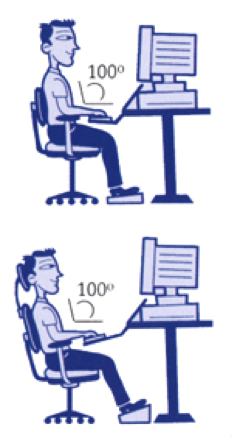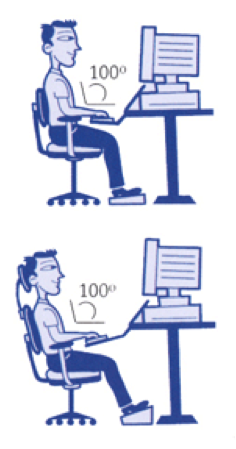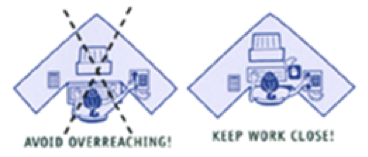Do you sit in a chair at work staring at a computer screen?
Do you suffer from back or neck related conditions?
One of the most common injuries diagnosed daily within private practice is posture related injuries, whether it is your lower back, upper back or neck. This article aims to provide education on the correct set-up for your workstation.

1. Keyboard and Desk
 Place your keyboard in a position so that your elbows are in a slightly opened position (100-110o), your forearms are horizontal to the floor and your wrists remain in a straight position. That is; make sure your hands are in line with the forearm.
Place your keyboard in a position so that your elbows are in a slightly opened position (100-110o), your forearms are horizontal to the floor and your wrists remain in a straight position. That is; make sure your hands are in line with the forearm.
If you prefer to have your wrists supported on a wrist rest or the desk, be careful not to extend or bend your wrist in an upward position.
 Place the keyboard directly in front of your body. Determine what section of the keyboard you use most frequently, and readjust the keyboard so it is centred with your body.
Place the keyboard directly in front of your body. Determine what section of the keyboard you use most frequently, and readjust the keyboard so it is centred with your body.
Tilt your keyboard according to the position in which you are sitting. You can do this by adjusting the keyboard feet at the back of the keyboard. If you sit forward or in an upright position, tilt your keyboard away from you. If you are reclined tilt your keyboard in a positive position to help maintain a straight wrist position.
Palm supports are good to maintain neutral postures and cushion hard surfaces. However, palm supports should only be used to rest the palms of the hands between keystrokes. Resting on the palm supports while typing is not recommended. Avoid using excessively wide palm supports, or palm supports that are higher than the space bar of your keyboard.
Ensure you place the mouse as close as possible to the keyboard. Placing it on a slightly inclined surface may bring it closer to the keyboard
2. Shoulders
Whilst at your work bench, make sure that with the correct height of your desk and chair that your shoulders remain in a relaxed state and not hunched. Side effects of having hunched shoulders can include; headaches, tightness of shoulders, lack of concentration, stiff neck etc.
3. Chair Height
 Adjust the seat tilt so that you are comfortable when you are working on the keyboard, usually this will be close to horizontal but some people prefer the seat tilted slightly forwards or reclined to 100-110 degrees.
Adjust the seat tilt so that you are comfortable when you are working on the keyboard, usually this will be close to horizontal but some people prefer the seat tilted slightly forwards or reclined to 100-110 degrees.
Make sure your upper and lower back are supported. If you don’t feel supported then Physiohealth offer a range of products such as backjoys and lumbar supports so please ask for more details. If you have an active back mechanism on your chair, use it to make frequent changes of you chair position.
Push your hips as far back as they can go in your chair. Your feet should be flat on the floor and knees bent at a comfortable angle greater than 90º flexion. If this places an uncomfortable strain on your leg muscles, or if your feet do not reach the floor, then a footrest should be used. The footrest height must allow your knees to be bent at 90º and equal to or slightly lower than your hips
Ensure your shoulders are completely relaxed as per above instructions.
4. Monitors, Documents, Phone and Keyboard
 Monitors
Monitors
Adjust your monitor and documents so that your neck remains in a neutral and relaxed position. Set your screen at a distance that allows you to most easily focus on the screen. Usually this will be within an arm’s length.
Centre the monitor directly in front of you above your keyboard. Set the height of the monitor so that the top of the screen is 2-3 inches above resting eye level and the bottom of the screen can be read without moving your head. Usually this means that the centre of the screen will need to be near shoulder height and your eyes shoulder be level with the tool bar.
People who wear bifocal or multi-focal lenses will need to get a balance between where they see out of their lenses and avoid too much bending of their neck. The height of the monitor can be adjusted using a riser or a book.
Document holder
 Place the document holder close to the monitor screen in the position that causes the least twisting or inclination of the head.
Place the document holder close to the monitor screen in the position that causes the least twisting or inclination of the head.
Place all controls and task materials within a comfortable reach of both hands so that there is no unnecessary twisting of any part of the body. Most people prefer the document holder to be between the keyboard and the monitor.
Phones
Avoid cradling the phone between your head and shoulder when answering calls. If you need to use your computer at the same time, use a headset or the phone’s hands-free/speaker-phone capabilities if the environment is suitable.
Using a mouse
A well-designed mouse should not cause pressure on the wrist and forearm muscles. A large mouse may keep your wrist continuously bent at an uncomfortable angle.
Pressure can be reduced by releasing the mouse at frequent intervals and by selecting a slim-line, low-profile mouse. Keep the mouse as close as possible to the keyboard, elbow bent and close to the body.
5. Postures and typing
Posture while typing
Good posture is essential. You should adopt a natural and relaxed position, providing opportunity for movement, so you can assume a number of alternative positions. There is no single, rigidly defined position; however your posture should be comfortable within the restrictions of your workstation set up.
Change your posture at frequent intervals to minimise fatigue. Avoid awkward postures at the extremes of the joint range, especially the wrists.
Take short 1-2 minute stretch breaks every 20-30 minutes. After each hour of work, take a break or change tasks for at least 5-10 minutes. Always try to get away from your computer during lunch breaks. Avoid sharp increases in work rate. Changes should be gradual enough to ensure that the workload does not result in excessive fatigue.
Avoid eye fatigue by resting and refocusing your eyes periodically. Look away from the monitor and focus on something in the distance. Rest your eyes by covering them with your palms for 10-15 seconds.
Typing technique
Using a keyboard requires skill, hence the need to learn correct typing technique. Unskilled (‘hunt and peck’) typists are particularly at risk of overuse injuries such as;
- Tennis elbow, often from using only one or two fingers which may overload the finger tendons.
- Are constantly looking from keyboard to screen to keyboard, which may strain neck muscles an cause tension/tightness
- Adopting a tense posture (wrists bent back and fingers ‘poised to strike’).
Speed of keying
Ten thousand to 12,000 keystrokes per hour is considered an acceptable standard.
Length of time on the keyboard
Fixed postures for long periods of time, increases the likelihood of muscular aches and pains. In addition, long periods of repetitive movement and sustained visual attention can also give rise to fatigue-related complaints such as headaches and visual deficits
It is recommended that you should avoid spending more than five hours a day on keyboard duties and no longer than 50 minutes per hour without a postural/stretching break.
Employees new to keyboard work, and staff returning from an absence of two or more weeks, need a period of adjustment. The adjustment may be achieved through reduced work rates, or alternative duties with a gradual reintroduction to keyboard work.
6. Lighting, glare and reflection
Lighting
Place the monitor to the side of the light source/s, not directly underneath. Try to have your desk between rows of lights. If the lighting is fluorescent strip lighting, the sides of the desk should be parallel with the lights. Try not to put the screen near a window. If it is unavoidable ensure that neither the screen nor the operator faces the window.
If the monitor is well away from windows, and there are no other sources of bright light, use a low level of light. If there are strong contrasting light levels, then a moderate level of lighting should be used
Glare and reflection
It is important to detect the presence of glare and reflection. To determine whether there is glare from overhead lights, sit down and hold an object such as a book above the eyes at eyebrow level and establish whether the screen image becomes clearer in the absence of overhead glare. To detect whether there are reflections from the desk surface, hold the book above the surface and assess the change in reflected glare from the screen.
You can eliminate or reduce the influence of these reflections in a number of ways:
- Tilting the screen (top part forwards) so that the reflections are directed below eye level.
- Cover the screen with a light diffusing surface or anti-glare screen.
- Negative contrast screen (dark characters on light background) will reduce these reflections.
- Alternatively, LCD screens are less susceptible to glare and reflections
If you experience eye discomfort when using a bright screen you should make the following adjustments:
- Turn the screen brightness down to a comfortable level.
- Look away into the distance in order to rest the eyes for a short while every 10 minutes or so.
- Change the text and background colours. We recommend black characters on white or yellow background, or yellow on black, white on black, white on blue and green on white. Avoid red and green and yellow on white.
7. Postural Exercises and Stretches
Please take the time to look at our website www.physiohealth.com.au and click on our “how to videos”. Alternatively you can download our Physiohealth mobile app on to your smart phone.
Take the time to look at the range of our postural and stretching videos we have. Always remember to speak to you Physiohealth Physiotherapist to make sure you are able to perform these exercises.
